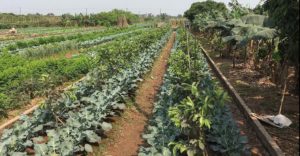by Gary Baise, IALF Board Member
First published on Farm Futures March 27, 2018
Vietnam experts see it becoming a much larger trading partner with the U.S.
For the past two weeks I have seen a much different agriculture in Southeast Asia. From experts such as J.P.Morgan’s agricultural advisor in Hong Kong to the U.S. Embassy, and USDA’s, I saw and heard the great opportunities for all of us in U.S. agriculture.
One theme which did surprise me is that China’s saber rattling regarding a potential tariff on soybeans is just that…saber rattling. Expert after expert had the common view that China would not impose a tariff. The experts had numerous reasons for reaching this conclusion. These views were expressed to members of the Illinois Agricultural Leadership Foundation class with whom I traveled to Hong Kong, Vietnam and Taiwan.

On average, Vietnamese farms average three-quarters of an acre, smaller than many U.S. backyards.
U.S. ag is admired
From the musty cells of the Hanoi Hilton to the flat lands surrounding Saigon, the trip was an eye opener as to how U.S. agriculture is respected, admired and relied on for both quality and quantity. The demand for U.S. products in Hong Kong and Taiwan was no surprise. Vietnam was another story.
My preconceived notion was that our time in Hanoi would be stressful and frankly ugly. I was 180 degrees wrong. From the tour guides, bus drivers, and people in coffee shops and restaurants there could be no more positive reception. Instead of seeking to distance themselves from the United States, there was and is a recurring theme of wanting to become closely allied with the United States and its agricultural prowess. Instead of a drab Communist city, I found a prosperous, skyscraper-filled, well organized city which we were told had been there over 1,000 years. Motor scooters with well dressed people were everywhere.

